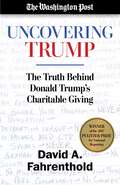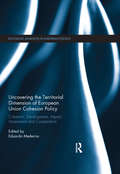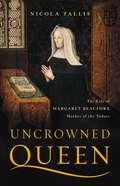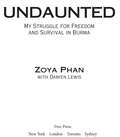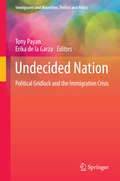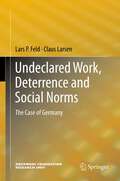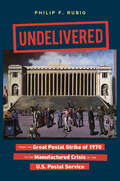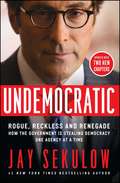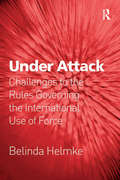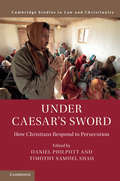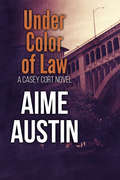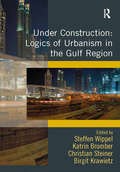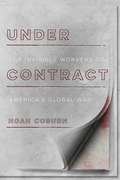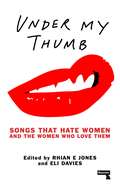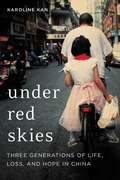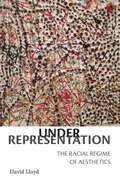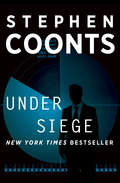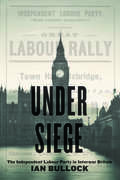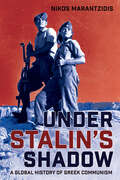- Table View
- List View
Uncovering Ideology in English Language Teaching: Identifying the 'Native Speaker' Frame (English Language Education #19)
by Robert J. LoweThis book introduces the concept of the ‘native speaker’ frame: a perceptual filter within English Language Teaching (ELT) which views the linguistic and cultural norms and the educational technology of the anglophone West as being normative, while the norms and practices of non-Western countries are viewed as deficient. Based on a rich source of ethnographic data, and employing a frame analysis approach, it investigates the ways in which this ‘native-speaker’ framing influenced the construction and operation of a Japanese university EFL program. While the program appeared to be free of explicit expressions of native-speakerism, such as discrimination against teachers, this study found that the practices of the program were underpinned by implicitly native-speakerist assumptions based on the stereotyping of Japanese students and the Japanese education system. The book provides a new perspective on debates around native-speakerism by examining how the dominant framing of a program may still be influenced by the ideology, even in cases where overt signs of native-speakerism appear to be absent.
Uncovering Trump: The Truth Behind Donald Trump's Charitable Giving
by David A. FahrentholdFrom David A. Fahrenthold, winner of the 2017 Pulitzer Prize for National Reporting, comes a fascinating behind-the-scenes look at the stories and scandals of Donald Trump&’s campaign. In February of 2016, Donald Trump promised $6 million in donations, including $1 million from his own pocket, to local charities along his campaign trail. But by the time he won the New Hampshire primary, he had stopped giving away money and had donated far less than his pledged amount. Washington Post reporter David A. Fahrenthold went in search of the missing money, and found a bigger story than he ever expected. In this collection of articles from The Washington Post, Fahrenthold chronicles his investigations on candidate Trump. From a deep dive into the Trump Foundation to breaking the news of the now-infamous &“Access Hollywood&” tape, the information he discovered shaped the course of the campaign and set the tone for the Trump presidency. A must-read for anyone who followed the 2016 campaign, Uncovering Trump takes you behind the scenes of Fahrenthold&’s investigation, through the lens of his expertly reported news stories.
Uncovering the Territorial Dimension of European Union Cohesion Policy: Cohesion, Development, Impact Assessment and Cooperation (Routledge Advances in European Politics)
by Eduardo MedeirosDespite the non-territorialised strategic goals of the EU 2020 Strategy, the long-term aim of EU Cohesion Policy to promote harmonious development of the European territory – social, economic, and ‘territorial cohesion’ – remains a central goal of achieving a more cohesive EU territory. This book examines the ‘territorial dimension’ of EU Cohesion Policy, specifically assessing territorial impacts at the various spatial levels, engaging theoretically and empirically with the notion and role of the ‘territorial dimension’ within a strongly fragmented EU policymaking process, and examining more generally EU Cohesion Policy, as the main driver of the EU territorial development process. It provides an updated and fresh theoretical discussion on the precise meaning of the ‘territorial dimension’ of policies and the relatively recent EU policy evaluation technique, known as ‘Territorial Impact Assessment’ (TIA). Assessing the history, relevance, efficiency and effectiveness of these procedures, it presents several empirical findings on the implementation of specific territorial-focus and place-based financial instruments, as part of the Territorial Agendas and the EU goal of achieving a more integrated, territorial approach. This text will be of key interest to scholars, students and practitioners of spatial planning and cohesion policy, European sector policies and European spatial planning, and more broadly to European and EU studies/politics, regional economic geography and public policy.
Uncrowned Queen: The Life of Margaret Beaufort, Mother of the Tudors
by Nicola TallisAn "impeccably researched and beautifully written" biography of Lady Margaret Beaufort, matriarch of the Tudor dynasty (Tracy Borman, author of The Private Lives of the Tudors and Elizabeth's Women). In 1485, Henry VII became the first Tudor king of England. His victory owed much to his mother, Lady Margaret Beaufort. Over decades and across countries, Margaret had schemed to install her son on the throne and end the War of the Roses. Margaret's extraordinarily close relationship with Henry, coupled with her role in political and ceremonial affairs, ensured that she was treated -- and behaved -- as a queen in all but name. Against a lavish backdrop of pageantry and ambition, court intrigue and war, historian Nicola Tallis illuminates how a dynamic, brilliant woman orchestrated the rise of the Tudors.
Undaunted: My Fight Against America's Enemies, At Home and Abroad
by John O. Brennan**THE INSTANT NEW YORK TIMES BESTSELLER**"John Brennan is one of the hardest-working, most patriotic public servants I've ever seen, and our country is better off for it. As president, he was one of my closest advisors and a great friend. And in his memoir, Undaunted, you'll see why. I hope you'll read it."—President Barack Obama <P><P>A powerful and revelatory memoir from former CIA director John Brennan, spanning his more than thirty years in government. <P><P>Friday, January 6, 2017: On that day, as always, John Brennan’s alarm clock was set to go off at 4:15 a.m. But nothing else about that day would be routine. That day marked his first and only security briefing with President-elect Donald Trump. And it was also the day John Brennan said his final farewell to Owen Brennan, his father, the man who had taught him the lessons of goodness, integrity, and honor that had shaped the course of an unparalleled career serving his country from within the intelligence community. <P><P>In this brutally honest memoir, Brennan, the son of an Irish immigrant who settled in New Jersey, describes the life that took him from being a young CIA recruit enamored with the mystique of spy work, secretly defiant enough to drive a motorcycle and sport a diamond earring, and invigorated by his travels in the Middle East to being the most powerful individual in American intelligence. He details his experiences with very different presidents and what it’s been like to bear responsibility for some of the nation’s most crucial and polarizing national security decisions. <P><P>He pulls back the curtain on the inner workings of the Agency, describing the selfless, patriotic, and invisible work of the women and men involved in national security. He also examines the insularity, arrogance, and myopia that have, at times, undermined its reputation in the eyes of the American people and of members of other branches of government. Through topics ranging from George W. Bush’s intervention in Iraq to his thoughts on the CIA’s controversial use of enhanced interrogation techniques to his eye-opening account of the planning of the raid that resulted in Bin Ladin’s death to his realization that Russia had interfered with the 2016 election, Brennan brings the reader behind the scenes of some of the most crucial moments in recent U.S. history. He also candidly discusses the times he has failed to live up to his own high standards and the very public fallouts that have resulted. With its behind-the-scenes look at how major U.S. national security policies and actions unfolded during his long and distinguished career—especially during his eight years in the Obama administration—John Brennan’s memoir is a work of history with strong implications for the future of America and our country’s relationships with other world powers. <P><P>Undaunted: My Fight Against America’s Enemies, at Home and Abroad offers a rare and insightful look at the often-obscured world of national security, the intelligence profession, and Washington’s chaotic political environment. But more than that, it is a portrait of a man striving for integrity; for himself, for the CIA, and for his country.
Undaunted: My Struggle for Freedom and Survival in Burma
by Zoya PhanOnce a royal kingdom and then part of the British Empire, Burma long held sway in the Western imagination as a mythic place of great beauty. In recent times, Burma has been torn apart and isolated by one of the most brutal dictatorships in the world. Now, Zoya, a young member of the Karen tribe in Burma, bravely comes forward with her astonishingly vivid story of growing up in the idyllic green mansions of the jungle, and her violent displacement by the military junta that has controlled the country for almost a half century. This same cadre has also relentlessly hunted Zoya and her family across borders and continents. Undaunted tells of Zoya's riveting adventures, from her unusual childhood in a fascinating remote culture, to her years on the run, to her emergence as an activist icon. Named for a courageous Russian freedom fighter of World War II, Zoya was fourteen when Burmese aircraft bombed her peaceful village, forcing her and her family to flee through the jungles to a refugee camp just over the border in Thailand. After being trapped in refugee camps for years in poverty and despair, her family scattered; as her father became more deeply involved in the struggle for freedom, Zoya and her sister left their mother in the camp to go to a college in Bangkok to which they had won scholarships. But even as she attended classes, Zoya, the girl from the jungle, had to dodge police and assume an urban disguise, as she was technically an illegal immigrant and subject to deportation. Although, following graduation, she obtained a comfortable job with a major communications company in Bangkok, Zoya felt called back to Burma to help her mother and her people, millions of whom still have to live on the run today in order to survive--in fact, more villages have been destroyed in eastern Burma than in Darfur, Sudan. After a plot to kill her was uncovered, in 2004 Zoya escaped to the United Kingdom, where she began speaking at political conferences and demonstrations--a mission made all the more vital by her father's assassination in 2008 by agents of the Burmese regime. Like Ayaan Hirsi Ali, Zoya has become a powerful spokesperson against oppressors, undaunted by dangers posed to her life.
Undecided Nation
by Tony Payan Erika de la GarzaThere is a broad consensus that the United States' immigration system is broken, yet the political momentum behind the movement has not yet led to a consensus on how to fix it. This momentum has stemmed from the agreement that we have an immigration "crisis" on our hands - millions of undocumented immigrants living and working in the United States under increasingly harsh conditions, tremendous spending on border security and enforcement measures without protection of civil rights, changing voter demographics, and other pressing issues have ushered in the moment for immigration reform. This book presents research and policy recommendations from leading U. S. immigration experts and scholars, who have many valuable insights and nuanced perspectives to offer to the current debate on immigration reform. The goal of this immigration study is to disseminate knowledge and policy recommendations to scholars, government officials, the media, and the general policy community on vital issues regarding the present question of immigration reform. This book discusses the future prospects of immigration reform and delves into various details, options, and obstacles related to immigration reform. The chapters presented shed light on a number of issues that are currently being debated in the immigration bill. Some of them address the salience of the immigration issue in Latino political behavior and the impact of demographic context. Other papers hone in on the landscape of legislative initiatives addressing immigration at the state and local levels, and some authors address the implications of immigration reform for the labor market and economic climate. The book will be of interest to both scholars and policy-makers concerned with immigration in the United States.
Undeclared Work, Deterrence and Social Norms
by Claus Larsen Lars P. FeldFor a long time, it has been the declared aim in many countries to fight tax evasion in all its different manifestations, from undeclared work by cleaners and gardeners in private households to tax evasion in the international capital markets. This study focuses on the phenomenon of undeclared work and the case of Germany, presenting the most comprehensive analysis of tax non-compliance for Germany to date, based on surveys conducted by the Rockwool Foundation. Theoretically, the analysis starts from the standard model of tax evasion as being influenced by the subjectively perceived extent of deterrence, the perceived marginal tax burden and social norms. Evidence is provided on the impact of deterrence and other factors on tax non-compliance, and several descriptive statistics are presented to better illustrate the natrure of undeclared work with regard to industry, region, education and other socio-economic characteristics.
Undelivered: From the Great Postal Strike of 1970 to the Manufactured Crisis of the U.S. Postal Service
by Philip F. RubioFor eight days in March 1970, over 200,000 postal workers staged an illegal "wildcat" strike--the largest in United States history--for better wages and working conditions. Picket lines started in New York and spread across the country like wildfire. Strikers defied court injunctions, threats of termination, and their own union leaders. In the negotiated aftermath, the U.S. Post Office became the U.S. Postal Service, and postal workers received full collective bargaining rights and wage increases, all the while continuing to fight for greater democracy within their unions. Using archives, periodicals, and oral histories, Philip Rubio shows how this strike, born of frustration and rising expectations and emerging as part of a larger 1960s-1970s global rank-and-file labor upsurge, transformed the post office and postal unions. It also led to fifty years of clashes between postal unions and management over wages, speedup, privatization, automation, and service. Rubio revives the 1970 strike story and connects it to today's postal financial crisis that threatens the future of a vital 245-year-old public communications institution and its labor unions.
Undemocratic: How Unelected, Unaccountable Bureaucrats Are Stealing Your Liberty and Freedom
by Jay SekulowJay Sekulow--one of America's most influential attorneys--explores the current political landscape in which bureaucracy has taken over our government and provides a practical roadmap to help take back our personal liberties.Jay Sekulow is on a mission to defend Americans' freedom. The fact is that freedom is under attack like never before. The threat comes from the fourth branch of government--the biggest branch--and the only branch not in the Constitution: the federal bureaucracy. The bureaucracy imposes thousands of new laws every year, without a single vote from Congress. The bureaucracy violates the rights of Americans without accountability--persecuting adoptive parents, denying veterans quality healthcare, discriminating against conservatives and Christians for partisan purposes, and damaging our economy with job-killing rules. Americans are bullied by the very institutions established to protect their right to life, liberty, and the pursuit of happiness. Our nation's bureaucrats are on an undemocratic power trip. But Jay has a plan to fight back. We can resist illegal abuse, we can reform a broken system, and we can restore American democracy. This book won't just tell you how to win, it will show you real victories achieved by Jay and the American Center for Law and Justice. Unless we can roll back the fourth branch of government--the most dangerous branch--our elections will no longer matter. Undemocratic is a wake-up call, a call made at just the right time--before it's too late to save the democracy we love.
Under Attack: Challenges to the Rules Governing the International Use of Force
by Belinda HelmkeUnder Attack makes a new contribution to the field of international relations in general and the study of international law and armed conflict in particular, in two core ways. First, it links information from varying disciplines, most notably international relations and international law, to form a comprehensive picture of state practice and the challenges it poses to the legal rules for the use of force. Secondly, it organises the information in such a way to identify two core groups of contemporary justifications used by states: humanitarian reasons and self-defence, both with their sub-categories. At the core of this book is the question of how state practice since 1990 has challenged the long-established legal regime on the international use of force. Are we merely witnessing a temporary and insignificant challenge to international law or are the rules genuinely under attack?
Under Caesar's Sword: How Christians Respond to Persecution (Cambridge Studies in Law and Christianity)
by Daniel Philpott Timothy Samuel ShahThe global persecution of Christians is an urgent human rights issue that remains under-reported. <P><P>This volume presents the results of the first systematic global investigation into how Christians respond to persecution. World-class scholars of global Christianity present first-hand research from most of the sites of the harshest persecution as well as the West and Latin America. Their findings make clear the nature of persecution, the reasons for it, Christian responses to it - both non-violent and confrontational - and the effects of these responses. Motivating the volume is the hope that this knowledge will empower all who would exercise solidarity with the world's persecuted Christians and will offer the victims strategies for a more effective response. This book is written for anyone concerned about the persecution of Christians or more generally about the human right of religious freedom, including scholars, activists, political and religious leaders, and those who work for international organizations.<P> Brings attention to the under-reported plight of persecuted Christians;.<P>Includes details of persecution in twenty-four countries.<P>Will help activists and officials respond more effectively to persecution.
Under Color of Law: A Casey Cort Novel (A Casey Cort Novel #2)
by Sylvie FoxLosing the most high profile case of her career ironically made Casey Cort a winner. Well-heeled clients now knock on her door, and Tom Brody, her rich ex-boyfriend, wants her back. But entry into the upper echelon comes at a price. The newest assistant United States attorney, Miles Siegel, has set his sights on nailing a public figure he believes to be corrupt: Cuyahoga County Juvenile Court Judge Eamon Brody. But Brody's brothers, one the presiding judge of the county, the other the state attorney general, aren't about to let that happen. When Casey gets retained by single mom Claire Henshaw, to wrest custody from her son's irresponsible father, Casey handles her first case before the controversial judge . . . and learns something that will force her to make the hardest decision of her life. In this continuation of the Casey Cort series, Sylvie Fox--a former trial lawyer in Cleveland--weaves a tale that blends the best of today's top legal thrillers with the heart and soul of women's fiction, in a story ripped from real-world headlines.
Under Construction: Logics Of Urbanism In The Gulf Region
by Steffen Wippel Katrin Bromber Birgit KrawietzInterdisciplinary in approach, this volume explores and deciphers the symbolic value and iconicity of the built environment in the Arab Gulf Region, its aesthetics, language and performative characteristics. Bringing together a range of studies by artists, curators and scholars, it demonstrates how Dubai appeared - at least until the financial crisis - to be leading the construction race and has already completed a large number of its landmark architecture and strategic facilities. In contrast, cities like the Qatari capital Doha still appear to be heavily ’under construction’ and in countries like the Sultanate of Oman, ultra-luxury tourism projects were started only recently. While the construction of artificial islands, theme parks and prestige sport facilities has attracted considerable attention, much less is known about the region’s widespread implementation of innovative infrastructure such as global container ports, free zones, inter-island causeways and metro lines. This volume argues that these endeavours are not simply part of a strategy to prepare for the post-oil era for future economic survival and prosperity in the Lower Gulf region, but that they are also aiming to strengthen identitarian patterns and specific national brands. In doing so, they exhibit similar, yet remarkably diverse modes of engaging with certain global trends and present - questionably - distinct ideas for putting themselves on the global map. Each country aims to grab attention with regard to the world-wide flow of goods and capital and thus provide its own citizens with a socially acceptable trajectory for the future. By doing that, the countries in the Gulf are articulating a new semiotic and paradigm of urban development. For the first time, this volume maps these trends in their relation to architecture and infrastructure, in particular by treating them as semiotics in their own right. It suggests that recent developments in this region of the world not only represen
Under Contract: The Invisible Workers of America's Global War
by Noah CoburnWar is one of the most lucrative job markets for an increasingly global workforce. Most of the work on American bases, everything from manning guard towers to cleaning the latrines to more technical engineering and accounting jobs, has been outsourced to private firms that then contract out individual jobs, often to the lowest bidder. An "American" base in Afghanistan or Iraq will be staffed with workers from places like Sri Lanka, Bangladesh, the Philippines, Turkey, Bosnia, and Nepal: so-called "third-country nationals." Tens of thousands of these workers are now fixtures on American bases. Yet, in the plethora of records kept by the U.S. government, they are unseen and uncounted—their stories untold. Noah Coburn traces this unseen workforce across seven countries, following the workers' often zigzagging journey to war. He confronts the varied conditions third-country nationals encounter, ranging from near slavery to more mundane forms of exploitation. Visiting a British Imperial training camp in Nepal, U.S. bases in Afghanistan, a café in Tbilisi, offices in Ankara, and human traffickers in Delhi, Coburn seeks out a better understanding of the people who make up this unseen workforce, sharing powerful stories of hope and struggle. Part memoir, part travelogue, and part retelling of the war in Afghanistan through the eyes of workers, Under Contract unspools a complex global web of how modern wars are fought and supported, narrating war stories unlike any other. Coburn's experience forces readers to reckon with the moral questions of a hidden global war-force and the costs being shouldered by foreign nationals in our name.
Under Fire: An American Story
by William Novak Oliver NorthAddressing, for the first time, the events that led to his trial, Oliver North explains his role in the Iran-Contra affair and discusses the involvement of other powerful politicos.-product description
Under Fire: The Untold Story of the Attack in Benghazi
by Fred Burton Samuel M. KatzThe New York Times bestselling inside account of the attack against the U.S. diplomatic and intelligence outposts in Benghazi, Libya.On the night of September 11, 2012, the American diplomatic mission at Benghazi, Libya, came under ferocious attack by a heavily armed group of Islamic terrorists. The prolonged firefight, and the attack hours later on a nearby CIA outpost, resulted in the deaths of four Americans, including the American ambassador to Libya, Christopher Stevens, the Information Officer, Sean Smith, and two former Navy SEALs, Tyrone Woods and Glen Doherty, working for the Central Intelligence Agency.After the fall of Qaddafi, Benghazi was transformed into a hotbed of fundamentalist fervor and a den of spies for the northern half of the African continent. Moreover, it became the center of gravity for terrorist groups strategically situated in the violent whirlwinds of the Arab Spring. On the eleventh anniversary of the 9/11 attacks against the United States, a group of heavily armed Islamic terrorists had their sights set on the U.S. diplomatic and intelligence presence in the city.Based on the exclusive cooperation of eyewitnesses and confidential sources within the intelligence, diplomatic, and military communities, Fred Burton and Samuel M. Katz reveal for the first time the terrifying twelve-hour ordeal confronted by Ambassador Christopher Stevens, Sean Smith, his Diplomatic Security (DS) contingent, and the CIA security specialists who raced to rescue them.More than just the minute-by-minute narrative of a desperate last stand in the midst of an anarchic rebellion, Under Fire is an inspiring testament to the bravery and selflessness of the men and women who put their country first while serving in one of the most dangerous regions in the world.
Under My Thumb: Songs That Hate Women and the Women That Love Them
by Rhian Jones Eli Davies Tamar ShlaimDiscussions and analyses of music – whether on TV, in books or in the music press – have always been full of the stories of men. When female fans appear in these stories it is often through the eyes and from the perspectives of men – as muses, groupies or fangirls – meaning that women’s own experiences, ideas and arguments about the music they love are marginalised or glossed over. Women in music are frequently fetishised and objectified both in song lyrics and in real life, viewed purely in relation to men and through their impact on the male ego. But this hasn’t stopped generations of women from loving, being moved by and critically appreciating music – however that music may feel about them.Under My Thumb: The Songs that Hate Women and the Women Who Love Them is a study of misogyny in music through the eyes of women. It will bring together stories from music writers and fans about artists or songs they love despite their questionable or troubling gender politics, as well as looking at how these issues intersect with race, class and sexuality.The collection explores the joys of loving music and the tensions, contradictions and complexities it can involve. It is intended to be as much celebration as critique - a kind of feminist guilty pleasures.
Under New Public Management
by Dorothy E. Smith Alison I. GriffithThe institutional ethnographies collected in Under New Public Management explore how new managerial governance practices coordinate the work of people doing front-line work in public sectors such as health, education, social services, and international development, and people management in the private sector.In these fields, organizations have increasingly adopted private-sector management techniques, such as standardized and quantitative measures of performance and an obsession with cost reductions and efficiency. These practices of "new public management" are changing the ways in which front-line workers engage with their clients, students, or patients.Using research drawn from Canada, the United States, Australia, and Denmark, the contributors expose how standardized managerial requirements are created and applied, and how they affect the practicalities of working with people whose lives and experiences are complex and unique.
Under Red Skies: Three Generations of Life, Loss, and Hope in China
by Karoline KanA deeply personal and shocking look at how China is coming to terms with its conflicted past as it emerges into a modern, cutting-edge superpower. <P><P>Through the stories of three generations of women in her family, Karoline Kan, a former New York Times reporter based in Beijing, reveals how they navigated their way in a country beset by poverty and often-violent political unrest. <P><P>As the Kans move from quiet villages to crowded towns and through the urban streets of Beijing in search of a better way of life, they are forced to confront the past and break the chains of tradition, especially those forced on women. <P><P>Raw and revealing, Karoline Kan offers gripping tales of her grandmother, who struggled to make a way for her family during the Great Famine; of her mother, who defied the One-Child Policy by giving birth to Karoline; of her cousin, a shoe factory worker scraping by on 6 yuan (88 cents) per hour; and of herself, as an ambitious millennial striving to find a job--and true love--during a time rife with bewildering social change. <P><P>Under Red Skies is an engaging eyewitness account and Karoline's quest to understand the rapidly evolving, shifting sands of China. <P><P> It is the first English-language memoir from a Chinese millennial to be published in America, and a fascinating portrait of an otherwise-hidden world, written from the perspective of those who live there.
Under Representation: The Racial Regime of Aesthetics
by David LloydUnder Representation shows how the founding texts of aesthetic philosophy ground the racial order of the modern world in our concepts of universality, freedom, and humanity. In taking on the relation of aesthetics to race, Lloyd challenges the absence of sustained thought about race in postcolonial studies, as well as the lack of sustained attention to aesthetics in critical race theory.Late Enlightenment discourse on aesthetic experience proposes a decisive account of the conditions of possibility for universal human subjecthood. The aesthetic forges a powerful “racial regime of representation” whose genealogy runs from enlightenment thinkers like Kant and Schiller to late modernist critics like Adorno and Benjamin. For aesthetic philosophy, representation is not just about depiction of diverse humans or inclusion in political or cultural institutions. It is an activity that undergirds the various spheres of human practice and theory, from the most fundamental acts of perception and reflection to the relation of the subject to the political, the economic, and the social.Representation regulates the distribution of racial identifications along a developmental trajectory: The racialized remain “under representation,” on the threshold of humanity and not yet capable of freedom and civility as aesthetic thought defines those attributes. To ignore the aesthetic is thus to overlook its continuing force in the formation of the racial and political structures down to the present. Across five chapters, Under Representation investigates the aesthetic foundations of modern political subjectivity; race and the sublime; the logic of assimilation and the stereotype; the subaltern critique of representation; and the place of magic and the primitive in modernist concepts of art, aura and representation.Both a genealogy and an account of our present, Under Representation ultimately helps show how a political reading of aesthetics can help us build a racial politics adequate for the problems we face today, one that stakes claims more radical than multicultural demands for representation.
Under Siege (Jake Grafton #3)
by Stephen CoontsA fighter pilot races to stop a terrorist plot in Washington, DC, in this thriller by a New York Times–bestselling author hailed as &“brilliant&” by Tom Clancy.When the psychotic Colombian drug lord Chano Aldana is extradited to the United States for trial, he brings his army of vicious mercenaries with him. And as Aldana&’s hit men target the President of the United States, the capital is plunged into chaos that only veteran fighter pilot Jake Grafton can stop. With the help of an investigative journalist and an undercover agent, Grafton must find the deadly assassins before they can strike again. But time is running out, and the future of the country hangs in the balance. This ebook features an illustrated biography of Stephen Coonts, including rare photos from the author&’s personal collection.
Under Siege: The Independent Labour Party in Interwar Britain
by Ian BullockDuring the period between the two world wars, the Independent Labour Party (ILP) was the main voice of radical democratic socialism in Great Britain. Founded in 1893, the ILP had, since 1906, operated under the aegis of the Labour Party. As that party edged nearer to power following World War I, forming minority governments in 1924 and again in 1929, the ILP found its own identity under siege. On one side stood those who wanted the ILP to subordinate itself to an increasingly cautious and conventional Labour leadership; on the other stood those who felt that the ILP should throw its lot in with the Communist Party of Great Britain. After the ILP disaffiliated from Labour in 1932 in order to pursue a new, “revolutionary” policy, it was again torn, this time between those who wanted to merge with the Communists and those who saw the ILP as their more genuinely revolutionary and democratic rival. At the opening of the 1930s, the ILP boasted five times the membership of the Communist Party, as well as a sizeable contingent of MPs. By the end of the decade, having tested the possibility of creating a revolutionary party in Britain almost to the point of its own destruction, the ILP was much diminished—although, unlike the Communists, it still retained a foothold in Parliament. Despite this reversal of fortunes, during the 1930s—years that witnessed the ascendancy of both Stalin and Hitler—the ILP demonstrated an unswerving commitment to democratic socialist thinking. Drawing extensively on the ILP’s Labour Leader and other contemporary left-wing newspapers, as well as on ILP publications and internal party documents, Bullock examines the debates and ideological battles of the ILP during the tumultuous interwar period. He argues that the ILP made a lasting contribution to British politics in general, and to the modern Labour Party in particular, by preserving the values of democratic socialism during the interwar period.
Under Stalin's Shadow: A Global History of Greek Communism (NIU Series in Slavic, East European, and Eurasian Studies)
by Nikos MarantzidisUnder Stalin's Shadow examines the history of the Communist Party of Greece (KKE) from 1918 to 1956, showing how closely national Communism was related to international developments. The history of the KKE reveals the role of Moscow in the various Communist parties of Southeastern Europe, as Nikos Marantzidis shows that Communism's international institutions (Moscow Center, Comintern, Balkan Communist Federation, Cominform, and sister parties in the Balkans) were not merely external factors influencing orientation and policy choices. Based on research from published and unpublished archival documents located in Greece, Russia, Eastern and Western Europe, and the Balkan countries, Under Stalin's Shadow traces the KKE movement's interactions with fraternal parties in neighboring states and with their acknowledged supreme mentors in Stalin's Soviet Russia. Marantzidis reveals how, because the boundaries between the national and international in the Communist world were not clearly drawn, international institutions, geopolitical soviet interests, and sister parties' strategies shaped in fundamental ways the KKE's leadership, its character and decision making as a party, and the way of life of its followers over the years.

